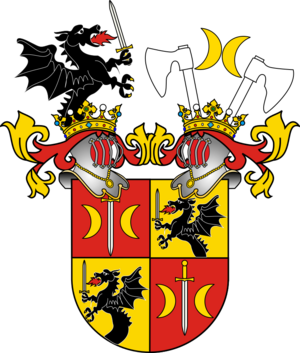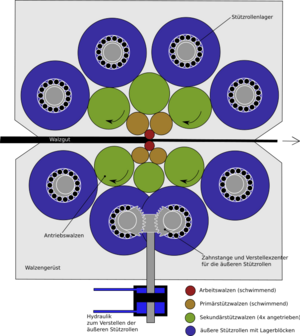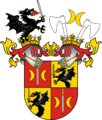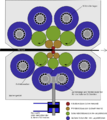Tadeusz Sendzimir facts for kids
Quick facts for kids
Tadeusz Sendzimir
|
|
|---|---|
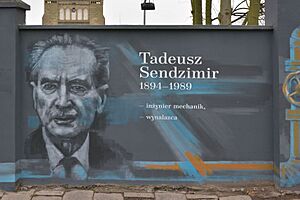
Sendzimir on a mural in Szczecin, 2018.
|
|
| Born |
Tadeusz Sędzimir
July 15, 1894 |
| Died | September 1, 1989 (aged 95) |
| Nationality | Polish |
| Education | Lviv Polytechnic |
| Occupation | Engineer, inventor |
| Known for | Sendzimir mill Sendzimir process |
| Spouse(s) | Barbara Alferieff (1922-1942) Bertha Madelaine Bernoda (1945) |
| Awards | Gold Cross of Merit (1938) Bessemer Gold Medal (1965) Brinell Gold Medal (1974) |
Tadeusz Sendzimir (born Sędzimir) was a famous Polish engineer and inventor. He was born on July 15, 1894, in Lviv, and passed away on September 1, 1989, in Jupiter, Florida.
Sendzimir held 120 patents for his inventions. Most of these were about mining and metallurgy, which is the science of working with metals. He created new ways to process steel and other metals. These methods are now used in many countries around the world. He received many important awards for his work. These included the Polish Gold Cross of Merit in 1938 and the Bessemer Gold Medal in 1965.
Contents
Early Life and Learning
Tadeusz Sendzimir was the oldest son of Kazimierz Sędzimir and Wanda Jaskółowska. Even as a child, he loved machines. When he was only 13, he built his own camera!
He went to school in Lviv. Then, he studied at the Politechnika Lwowska. But the school closed when Russian troops took over Lviv. So, he moved to Kiev. There, he worked with cars and at a business office. This helped him learn Russian and English.
Later, a big change happened in Russia in 1917. Sendzimir had to leave and traveled far away to Vladivostok. From there, he went to Shanghai, China. In Shanghai, he built China's first factory to make screws, nails, and wire.
New Ideas and Moving to America
In 1922, Sendzimir married Barbara Alferieff. Their son, Michael, was born two years later. Sendzimir started working on a new way to galvanize steel. Galvanizing means covering steel with a layer of zinc to stop it from rusting.
He found that steel still rusted because the zinc wasn't sticking well. It was bonding to a thin layer of iron rust instead of the iron itself. He figured out how to fix this problem.
In 1929, Sendzimir tried to share his ideas with American business leaders. But it was the start of the Great Depression, a tough economic time. So, no one was interested.
He returned to Poland in 1930. There, he built his first special rolling mill. A year later, he helped build a factory in Kostuchna that used his new method. This method was for continuously coating steel sheets with zinc. It became known worldwide as the Sendzimir process. He explained it like this: "Imagine rolling out hard dough. It would be faster if someone helped stretch it by holding the edges."
In 1934, he created another invention. This was a way to cold roll thin metal sheets. It was used in a steelworks in Ruda Śląska, Poland.
Working in the United States
Sendzimir built a steel mill in Butler, Pennsylvania, in 1936. By 1938, a company called Armco Steel became interested in his work. They partnered with him to spread his galvanizing and mill technology around the world.
In 1939, Sendzimir moved to Middletown, Ohio. His special mill could roll very hard materials into thin sheets. In the 1940s, he started his own company, T. Sendzimir, Inc., in Waterbury, Connecticut.
In 1945, he married Bertha Bernoda. The next year, he became a citizen of the United States. For a while, his achievements were not recognized in Poland. But later, a new leader in Poland changed this. Sendzimir was given an important Polish award.
In 1975, he received an honorary degree from a university in Kraków. Sendzimir's methods for galvanizing steel were very successful. His Z-mill, a type of rolling mill, made silicon steel flexible enough for use in radar. Between 1953 and 1989, he brought his Z-mills to Great Britain, Japan, and Canada. In 1974, he invented a spiral steel looper, used in the United States and Japan.
By the early 1980s, about 90% of the world's galvanized steel was made using the Sendzimir process. Countries like Poland, France, the United Kingdom, Japan, and Canada bought his steel mills and technology. Sendzimir also strongly supported Polish-American organizations.
Tadeusz Sendzimir passed away after a stroke. He was buried in a special zinc-plated coffin, designed by him.
Remembering Tadeusz Sendzimir
In 1986, on the 100th anniversary of the Statue of Liberty, Tadeusz Sendzimir was honored. He was recognized as one of the important immigrants who helped America.
In 1989, a film called Sendzimir was made about his life and work.
In 1990, a large steel plant in Kraków, Poland, was renamed the Tadeusz Sendzimir Steelworks in his honor. Also, the AIST Tadeusz Sendzimir Memorial Medal was created that same year.
Images for kids
See also
- Sendzimir process
- Ostoja coat of arms
- Clan of Ostoja
- Timeline of Polish science and technology
- List of Polish inventors and discoverers


